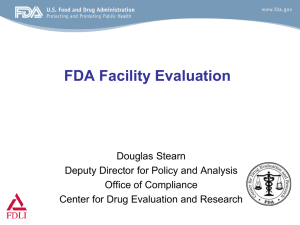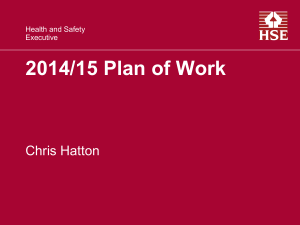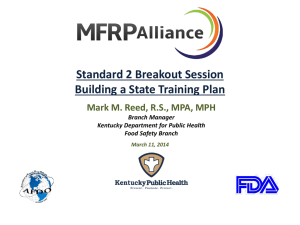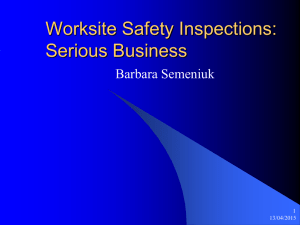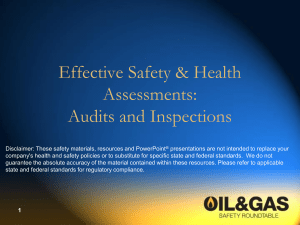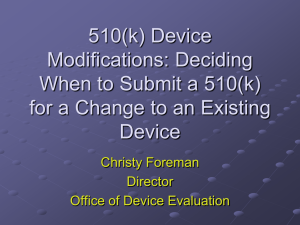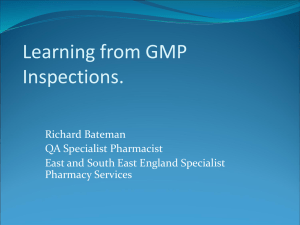Ross FDA Foreign Priorities, Inspections and Compliance
advertisement
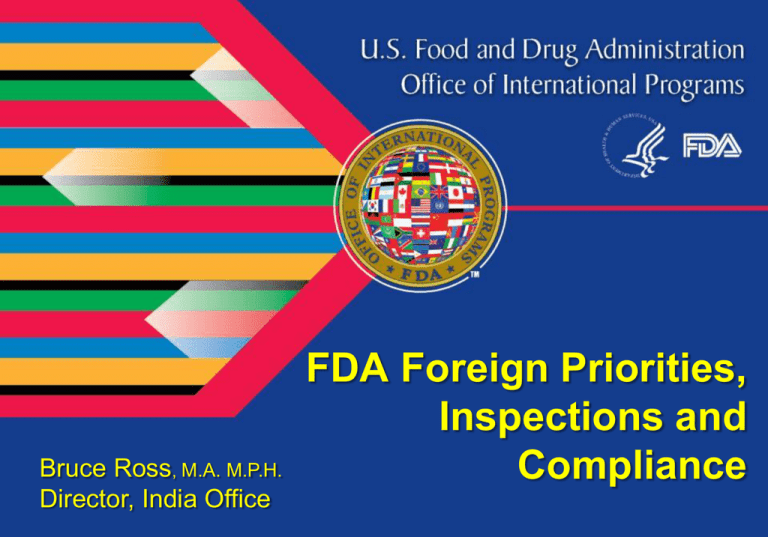
Bruce Ross, M.A. M.P.H. Director, India Office FDA Foreign Priorities, Inspections and Compliance Agenda • Priorities • Challenges of globalization • cGMP deficiencies • Comparison • Post inspection regulatory actions 2 FDA Strategic Priorities 2011-2015 Advance Regulatory Science: the science of developing new tools, standards and approaches to assess the safety and effectiveness, quality and performance of FDA-regulated products Strengthen the safety and integrity of the global supply chain • A paradigm shift is required to meet this • • challenge: focus on prevention of threats Innovative analytical tools International capacity building 3 Advancing Regulatory Science 1. Modernize Toxicology 2. Stimulate Innovation in Clinical Evaluations 3. Support New Approaches to Improve Product Manufacturing and Quality 4. Ensure FDA Readiness to Evaluate Innovative Emerging Technologies 5. Harness Diverse Data through Information Sciences 6. Implement a New Prevention-Focused Food Safety System to Protect Public Health 7. Facilitate Development of Medical Countermeasures 8. Strengthen Social and Behavioral Science Make Informed Decisions about Regulated Products 4 Pathway to Global Product Safety and Quality Global economic forces are having a dramatic effect on food and drug supply chains. Cross border flows of goods, information and capital are increasing much faster than global GDP. U.S. Imports in 2009: • • • • • 10-15% of food consumed 30% of drugs by value 80% of API used in US 50% of medical devices http://www.fda.gov/AboutFDA/CentersOffices/OfficeofGlobalReg ulatoryOperationsandPolicy/GlobalProductPathway/default.htm Expected annual growth 5-15% 5 Four Pillars of the Strategy 1. Create global coalitions of regulators 2. Build global data-information systems and networks and proactively share data with peers 3. Expand intelligence-gathering, with an increased focus on risk analytics 4. Effectively allocate agency resources based on risk, and leveraging government, industry and public and private third parties 6 Globalization Challenges Explosion of production of FDA-regulated goods Distinction between domestic and imported products is obsolete Supply chain more complex, oversight much more difficult FDA-regulated products originate from more than 150 countries and pass through 300 ports of entry • 130,000 importers • 300,000 foreign facilities Increase in variety and complexity of imported medical products Growing demand, yet constrained supply 7 Understanding FDA’s Approach and Expectations Communicate Leverage Resources Establish and use new “tools” Secure supply chain Become a global agency • Stop distinguishing between foreign and domestic procedures, policies, and expectations 8 FDA Foreign Offices London Brussels Headquarters Silver Spring, MD Mexico City Beijing Amman New Delhi Mumbai San Jose Santiago Pretoria 9 Shanghai Guangzhou Objectives of FDA’s Foreign Offices Gain improved knowledge about product manufacturing and transport to the United States; Leverage knowledge and resources and strengthen capacity to better assure product safety; Work with regulated industry so they will better understand FDA regulations, standards and guidance; Coordinate with USG colleagues in-country (e.g., USDA/FAS, DOC/CBP, USAID, USTR,) on approaches to enhance product safety; and Increase capacity to perform more timely FDA overseas inspections, especially of high risk products. 10 FDA’s Enforcement Priorities Drug quality in OTCs Assure investigations (complaints, rejects) are prompt and root causes corrected Data integrity and quality systems Supply chain security • Contract manufacturers • Raw material/excipient vendor qualification programs 11 FDA’s Enforcement Priorities Combating economically motivated adulterated products/ingredients Field alert reporting (defect reports) Contaminated, sub- or super-potent, high- risk compounded drugs Post-market adverse event reporting 12 Major Inspection Types 1. Pre-approval 2. “For-cause” or directed 3. Post-marketing adverse drug event 4. CGMP surveillance (routine) 13 Foreign establishments routinely inspected Manufacturers of drugs, including • API and dosage form • human and animal • biotech, vaccine, etc. (biologicals) Re-packagers/re-labelers Independent sterilizers Independent laboratories 14 FDA’s Inspectorate 1,700 investigators in our field offices conducting domestic inspections About 400 investigators and 150 analysts qualified to conduct foreign inspections (all commodities) Dedicated Foreign Cadres – Drugs – Foods – Medical devices 15 FDA Foreign Inspections since 2008 2500 2000 2217 1500 1422 1000 1220 945 500 0 2008 2009 2010 Fiscal Year 16 2011 FDA’s Foreign Inspection Accomplishments 1600 1422 1400 1220 1200 933 1000 800 600 400 1006 767 148 845 790 96 132 125 329 153 350 270 354 945 153 259 277 325 687 686 2009 2010 262 287 264 200 213 374 370 342 2004 2005 2006 499 491 2007 2008 0 2003 17 Other Foods Devices Drugs FDA Foreign Inspections types & numbers Factors which result in inspections • Pre-Approval Submissions (PEPFAR) • Routine surveillance • Follow - up • Food assessments • MOUs/international agreements • Import issues • Emergencies 1400 1200 1000 Foods 800 Drugs Devices 600 Vet Biologics 400 200 0 2006 18 2008 2011 FDA Foreign GMP Inspections 600 500 400 PAI GMP 300 GMP 200 100 0 2002 2003 2004 2005 2006 2007 19 2008 2009 2010 2011 FDA’s Foreign Inspections by country, FY 2010 Canada, 94 Germany, 132 Italy, 66 Switzerland, 42 Spain, 40 France, 59 Japan, 71 Others, 66 China, 133 India, 138 20 FY 11 International inspection obligation per program area Drugs – 1249 1400 Devices - 472 1200 Foods - 994 1000 CVM - 88 800 Biologics - 42 600 400 TOTAL – 2825* 200 0 21 Drugs Devices Foods CVM Biologics India inspections (FY 2008-2012) 120 100 80 Devices Drugs 60 BIMO 40 Foods 20 0 2008 2009 2010 2011 22 2012* * Partial year Drug Inspections in India Breakdown by inspection category 160 140 120 100 BIMO 80 3 60 3 40 20 0 1 1 10 18 9 10 42 43 4 0 3 63 52 63 56 59 46 34 33 31 23 GMP PAI-GMP FDA inspection process 24 Inspections… Are fact finding Require evidence Require organization and time management Are regulatory 25 Purpose of GMP Audits To ensure that adequate quality systems are maintained. To assess compliance with the cGMP’s and firm’s standard operating procedures. To identify problems that can impact product quality. To assure there is a procedure for investigating non-compliance with the quality system and for prescribing and verifying corrective action. The procedures should include a description of how records of corrective actions are maintained. System Based Inspections GMP Inspections will follow a system based inspectional approach. The Quality System will always be covered while coverage of the other 5 systems will be rotated. • • • • • • Quality System Facilities and Equipment System Materials System Production System Laboratory System Packaging and Labeling System Product Risk Analysis Common Elements • Difficulty associated with manufacturing process, products with most critical manufacturing steps (sterile/non-sterile, wet granulation/dry blends, suspensions/solutions Hazard identification • Severity ranking • Probability ranking (with cause identification) • Assessment of risk level for each identified hazard (risk matrix) Inspection objectives Conduct inspection in accordance with FDA law and regulations Current Good Manufacturing Practice Accomplish what is necessary per established inspection procedures (“Compliance Programs”) Follow-up on additional questions/ concerns in inspection assignment 29 CGMP Inspection Programs (Compliance Program Guidance Manuals) Pre-approval: 7346.832/7352.832, Pre-Approval Inspections/Investigations Post-Approval/Surveillance: 7356.002, Drug Process Inspections Sterile Drug Process Inspections Drug Repackers and relabelers Radioactive Drugs Compressed Medical Gases Active Pharmaceutical Ingredients Process Inspections Inspections of Licensed Biological Therapeutic Drug Products Refer to: http://www.fda.gov/ICECI/ComplianceManuals/ComplianceProgramManual/default.htm 30 Inspection Participation Investigators (inspectors) Analysts (lab experts) GMP Assessors/Evaluators Product Reviewers/Assessors Other Specialists 31 Systems-Based Approach Quality Systems Materials Management Production Facilities & Equipment Packaging & Labeling Laboratory Control 32 Conduct of an inspection Quality • Annual Product Reviews • List of non-conformance reports • Out-of-specification results • Complaints • Rejected/Aborted/Destroyed batches • Field Alerts (defect reports) • Corrective actions since previous inspection 33 Conduct of an inspection Materials Management (ingredients & packaging) • Separation and control of materials • Identification of materials • Labeling practices • Sampling of incoming materials • Inventory control systems 34 Conduct of an inspection Production • Personnel practices • Contemporaneous completion of documents • Written procedures • Calibration stickers for critical equipment • Condition of equipment 35 Conduct of an inspection Facilities & Equipment • Equipment design • Heating/Ventilation/Cooling systems • Water systems 36 Conduct of an inspection Packaging and Labeling • Appropriate controls • Line clearance procedures • Visual inspection procedures (sterile products) • Label issuance and reconciliation documents 37 Conduct of an inspection Laboratory control • Raw data practices • Sample flow • Sample/standard identification • Status of the instruments • Stability • Methods in use 38 Conclusion of an inspection Formal close out May include: • Sample collections • Issuance of FDA 483, Inspectional Observations 39 FY 2009 cGMP deficiencies systems cited Laboratory System 29% Packaging & Labeling 5% Production System 10% Material System 4% QA System 39% Facility & Equipment 13% 40 FY 2011 cGMP deficiencies systems cited Lababoratory System 27% Packaging & Labeling 5% Material System 6% QA System 29% Production System 24% Facility & Equipment 9% 41 Top 10 deficiencies cited 2011 international inspections Inadequate Quality Systems Lack of investigations of batches that fail to meet specifications Lack of written procedures or inadequate SOPs Inadequate laboratory controls Un-validated test methods Inadequate stability program Inadequate process validation or no process validation Lack of process controls that validate the performance of manufacturing process Inadequate validation of equipment cleaning and maintenance cleaning Inadequate controls of components, intermediates, and raw materials 42 cGMP deficiency observations for international inspections Packaging & Labeling Laboratory System Production System 2011 2009 Material System Facility & Equipment QA System 0 10 20 43 30 40 50 FY 2010 cGMP deficiencies cited in India Production System 21% Material System 4% Packaging & Labeling 1% Facilities/Equipment 20% QA Systems 37% Laboratory System 17% 44 Top 10 deficiencies cited in 2011 in India Inadequate Quality Systems Lack of investigations of batches that fail to meet specifications Deficient records and reports Inadequate process validation or no process validation Lack of process controls that validate the performance of manufacturing process Inadequate laboratory controls Inadequate stability program Lack of written procedures or inadequate SOPs Inadequate controls of components, intermediates, and raw materials Inadequate validation of equipment cleaning and maintenance cleaning 45 Comparing cGMP deficiencies (Europe, China & India) 40 37 35 30 29 29 25 25 20 15 10 23 20 24 20 17 13 Europe China India 15 7 5 5 7 4 5 5 1 0 QA System Facility & Production Equipment System Material System 46 Laboratory Packaging System & Labeling After the inspection Write the Establishment Inspection Report (EIR) • Must be done in a timely manner Submit recommendation EIR reviewed by GMP product experts Final classification of inspection (acceptable, unacceptable: Warning Letter, Untitled Letter, Import Alert etc.) 47 Warning and Untitled Letters drug sites - 2005 to 2010 20 18 16 14 12 10 Warning Letters Untitled Letters 8 6 4 2 0 2005 2006 2007 2008 48 2009 2010 Source CDER ICB International Warning Letters issued 2009 & 2010 49 Global marketplace Ensuring safe, effective and quality foods and drugs for the citizens of India, the United States and the world 50 Key Initiatives 1. Set post-inspection deadlines 2. Take responsible steps to speed the warning letter process 3. Work more closely with FDA’s regulatory partners. 51 Key Initiatives 4. Swift, appropriate enforcement action with prioritizing on follow-up. 5. Be prepared to take immediate action in response to public health risks 6. Develop and implement a formal warning letter “close-out” process 52 Questions? NDBoxFDAIndiaOffice@state.gov Bruce.Ross@fda.hhs.gov 54 Bruce Ross, M.A., M.P.H. Country Director, India Bruce.Ross@fda.hhs.gov
